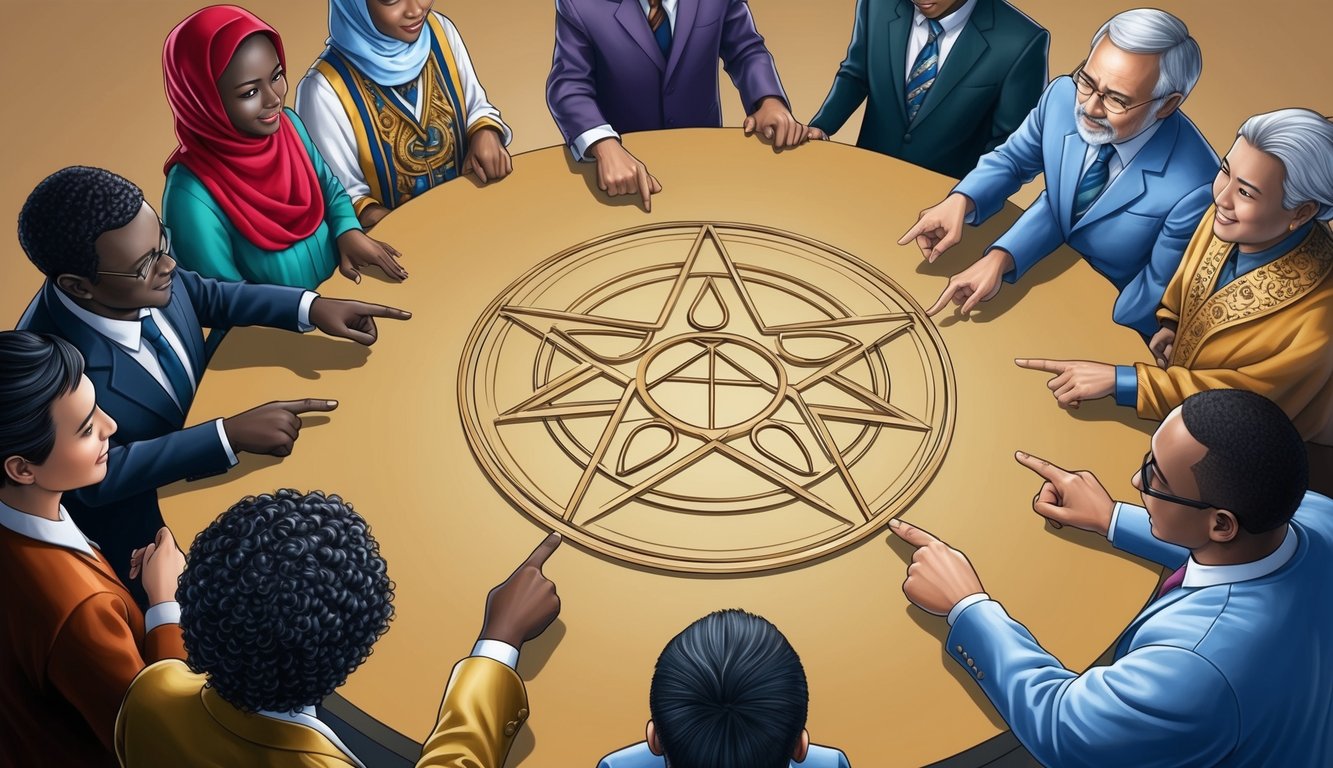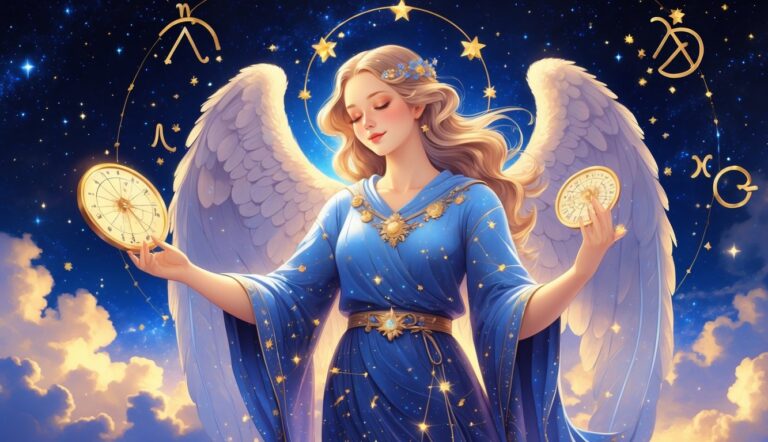Align Your Life with Your True North
The Power Quadrant System decodes your natural talents and pinpoints the career, timing and relationships that let you earn more, love deeper, and wake up eager for the day.
- Uncover your #1 high-income strength
- Draw in partners who raise your energy
- Work when your body’s clock is in “flow”
The pentagram, a five-pointed star, has captivated human imagination for millennia.
You’ve likely encountered this symbol in various contexts, from ancient religious artifacts to modern pop culture.
Its meaning has evolved and diversified over time, taking on significance in different spiritual traditions and belief systems.
The pentagram symbolizes the five elements of nature – earth, air, fire, water, and spirit – and represents the harmony between these forces. This connection to the natural world has made it a popular symbol in pagan and Wiccan practices.
You might also recognize it from its use in occult traditions, where it’s often associated with protection and magical rituals.
Despite its sometimes controversial reputation, the pentagram has a rich history in mathematics, art, and spirituality.
You’ll find it used in Christianity as a representation of the five wounds of Christ, and in ancient Greece as a symbol of mathematical perfection.
Whether you’re drawn to its geometric elegance or intrigued by its mystical associations, the pentagram continues to be a powerful and multifaceted symbol in our modern world.
Historical Background
The pentagram has a rich history spanning thousands of years across diverse cultures.
This five-pointed star symbol has undergone significant transformations in meaning and use throughout the ages.
Origins of the Pentagram Symbol
The pentagram’s origins trace back to ancient Mesopotamia around 3500 BCE.
Decode Your Personal Success Blueprint
Power Quadrant System shows you the exact career, relationships, and daily rhythm that match your natural DNA—so you earn more, work happier, and connect deeper.
- Pinpoint your #1 money-making talent
- Erase conflict & attract ideal partners
- Multiply productivity with perfect timing
Early Sumerians used it in cuneiform scripts, often associating it with royalty and celestial bodies.
In these early days, the symbol held positive connotations, representing divine power and protection.
As the pentagram spread to other civilizations, its meaning evolved.
Ancient Greeks saw mathematical perfection in its geometry.
Pythagoras and his followers revered it as a symbol of health and spiritual unity.
The symbol’s five points came to represent the five classical elements: earth, air, fire, water, and spirit.
This connection to nature and the cosmos furthered its mystical significance.
Pentagram in Ancient Civilizations
In ancient Egypt, the pentagram was linked to the underground deity Anubis.
Egyptians viewed it as a symbol of the afterlife and spiritual transformation.
Tap Into Your Built-In Success GPS
The Power Quadrant System deciphers your genetic blueprint so you can lock onto the career, income and relationships that feel effortless—and wildly rewarding.
- Zero in on your natural high-earning genius
- Sync with partners who boost your vibe
- Wake up driven, finish days fulfilled
Ancient Hebrews associated the pentagram with the Pentateuch, the first five books of the Hebrew Bible.
It represented truth and the five senses.
For the Celts, the five points symbolized the five stages of life: birth, initiation, consummation, repose, and death.
They used it in various rituals and as a protective charm.
Chinese culture saw the pentagram as a representation of the five elements: wood, fire, earth, metal, and water.
It played a role in feng shui practices and traditional medicine.
Evolution into Modern Usage
During the Middle Ages, Christian mystics adopted the pentagram, associating its five points with the five wounds of Christ.
It became a symbol of divine protection against evil forces.
The Renaissance period saw a resurgence of interest in ancient symbolism.
Occultists and alchemists incorporated the pentagram into their practices, viewing it as a powerful magical symbol.
In the 19th century, the symbol gained popularity among neopagan and Wiccan traditions.
They embraced its connection to nature and the elements, using it in rituals and as a sign of their faith.
Today, the pentagram’s meaning varies widely depending on cultural context.
It remains a significant symbol in various spiritual practices, while also finding its way into popular culture and art.
Symbolic Meanings
The pentagram holds diverse symbolic meanings across various belief systems and cultures.
Its five points represent different concepts depending on the context and interpretation.
In many traditions, the pentagram is associated with the elements—earth, air, fire, water, and spirit—reflecting a balance of natural forces.
It has been used in religious, mystical, and protective practices, often serving as a powerful emblem of harmony and guidance.
As one of many spiritual symbols and meanings found throughout history, the pentagram continues to be a subject of fascination and reverence in both modern and ancient traditions.
Pagan and Wiccan Beliefs
In Pagan and Wiccan traditions, the pentagram symbolizes the five elements: earth, air, fire, water, and spirit.
Each point corresponds to an element, with spirit typically at the top.
The symbol is often used for protection and to invoke positive energy.
When enclosed in a circle, it’s called a pentacle, representing the unity of all elements.
Wiccans may wear or display pentagrams as a sign of their faith.
In rituals, it’s used to cast circles and call upon elemental forces.
Christian Interpretations
Christian views on the pentagram have varied throughout history.
Early Christians sometimes used it to represent the five wounds of Christ.
However, later interpretations associated it with negative connotations.
Some linked it to occult practices or devil worship, especially when inverted.
This shift in perception led to its use in Gothic literature and horror films as a symbol of the supernatural or evil.
Occult and Esoteric Associations
In occult traditions, the pentagram is a powerful magical symbol.
It’s often used in ceremonial magic and Hermetic practices.
The upright pentagram is associated with positive energy and spiritual ascension.
The inverted pentagram, with two points up, is sometimes linked to darker practices.
Aleister Crowley, a famous occultist, incorporated the pentagram into his teachings.
In Tarot, it appears in the suit of pentacles, representing material wealth and earthly concerns.
Universal Elements Representation
Beyond specific belief systems, the pentagram can represent universal concepts.
Its five points are sometimes associated with the human body – head, arms, and legs.
In this interpretation, it symbolizes humanity and the microcosm of the universe.
Some see it as a representation of the golden ratio, embodying mathematical perfection.
The pentagram has also been used to symbolize health and harmony.
Its continuous line formation is seen as a representation of the interconnectedness of all things.
Geometric Properties
The pentagram’s fascinating structure embodies profound mathematical concepts.
Its symmetry and proportions reveal connections to sacred geometry and the golden ratio.
Mathematical Characteristics
The pentagram is a regular star polygon formed by connecting the vertices of a pentagon with straight lines.
It has five-fold rotational symmetry, meaning it looks the same after being rotated by 72 degrees.
Each internal angle measures 36 degrees.
When inscribed in a circle, the pentagram divides the circle’s diameter according to the golden ratio.
This creates segments in the proportion of approximately 1:1.618, a ratio found throughout nature and art.
The pentagram contains ten triangles – five acute isosceles triangles and five obtuse isosceles triangles.
The acute triangles have angles of 36°, 72°, and 72°.
Golden Ratio Relations
You’ll find the golden ratio embedded throughout the pentagram’s structure.
The ratio of the length of a pentagram’s edge to the length of its inner segment is φ (phi), the golden ratio.
This captivating property links the pentagram to concepts of ideal beauty and harmony in design.
Ancient Greek mathematicians were particularly fascinated by these golden ratio relationships.
The pentagram can be used to construct a golden rectangle.
By extending certain lines of the pentagram, you create a rectangle with sides in the golden ratio proportion of 1:1.618.
These golden ratio properties give the pentagram an aesthetic appeal that has captivated artists and designers for centuries.
Cultural Impact
The pentagram has left an indelible mark on various forms of cultural expression.
You’ll find its influence extending from classic literature to modern pop culture, often evoking both fascination and controversy.
Pentagram in Literature and Art
In literature, you might encounter the pentagram in works like Goethe’s “Faust,” where it serves as a protective symbol.
Artists have incorporated this five-pointed star into paintings, sculptures, and designs for centuries.
You’ll see it featured in occult-themed artworks, sometimes as a focal point or hidden symbol.
Renaissance artists used the pentagram to represent mathematical perfection and divine proportions.
In more recent times, it has become a common motif in fantasy and gothic art styles.
You might spot it adorning book covers, album artwork, or even tattoo designs.
Use in Popular Media
Turn on your TV or open a comic book, and you’re likely to come across the pentagram.
It’s a go-to symbol for creators looking to add a touch of mysticism or the supernatural to their works.
You’ll find it in popular TV shows about witches and demons, often glowing ominously or used in spell-casting scenes.
Video games frequently feature pentagrams in fantasy or horror settings.
They might serve as power-ups, magical portals, or sinister cult symbols.
In music, particularly metal and rock genres, you’ll see the pentagram on album covers and merchandise.
It’s become a visual shorthand for rebellion and alternative subcultures.
Controversies and Misconceptions
The pentagram has faced numerous controversies and misconceptions throughout history.
Its symbolism has often been misunderstood and misrepresented, leading to negative associations in popular culture and society.
Misinterpretation in Media
You’ve probably seen the pentagram portrayed negatively in movies, TV shows, and books.
It’s often used as a shorthand for evil or demonic practices.
This misrepresentation has led many to believe the symbol is inherently malevolent.
In reality, the pentagram has diverse meanings across different cultures and belief systems.
It’s been used in ancient civilizations, Christianity, and various spiritual practices as a symbol of protection and balance.
Media depictions often ignore this rich history, focusing instead on sensationalized portrayals.
This has contributed to widespread misunderstanding of the symbol’s true significance.
The Satanic Panic Perspective
You might remember the “Satanic Panic” of the 1980s and early 1990s.
During this period, fear and hysteria spread about alleged widespread Satanic ritual abuse.
The pentagram became a focal point of these fears.
It was often cited as evidence of Satanic activity, despite its long-standing use in various non-Satanic contexts.
This perspective led to unfounded accusations and moral panic.
Many innocent people were affected by these misconceptions.
The pentagram’s association with Satanism during this time further cemented its negative reputation in the public eye.
Even today, some continue to view the pentagram solely through this distorted lens, ignoring its broader cultural and spiritual significance.
Modern Practices
The pentagram remains a significant symbol in various spiritual and occult traditions today.
Its use spans contemporary Pagan practices and esoteric studies, carrying diverse meanings and applications.
Pentagram in Contemporary Paganism
In modern Pagan traditions, the pentagram holds a central role.
You’ll often see it worn as jewelry or used in rituals for protection.
Many Wiccans and Neo-Pagans view the five points as representing the elements – earth, air, fire, water, and spirit.
This symbol is frequently incorporated into altars and sacred spaces.
During rituals, you might trace a pentagram in the air to invoke elemental energies or create a protective barrier.
Some Pagan groups use different orientations of the pentagram to represent specific deities or concepts.
Significance in Occult Traditions
Occult practices continue to employ the pentagram in various ways.
You’ll find it used in ceremonial magic, often as part of complex rituals and spellwork.
Some traditions associate specific elements or spiritual entities with each point of the star.
In Tarot, the pentagram appears in the suit of Pentacles, linking it to earthly matters and material wealth.
Occult authors and practitioners have developed intricate systems of correspondences, connecting the pentagram to numerology, astrology, and Kabbalah.
Many modern occultists use the pentagram for meditation and visualization exercises.
You might encounter it in esoteric artwork or as a focal point for energy work and spiritual development practices.
Personal and Spiritual Use
The pentagram holds deep significance for many spiritual practitioners.
You can incorporate this powerful symbol into your personal practice through meditation, rituals, and wearing it as jewelry or amulets.
Meditation and Ritual Use
When meditating with a pentagram, you might visualize its five points to connect with elemental energies.
Focus on each point in turn – earth, air, fire, water, and spirit.
This can help balance and align your energies.
In rituals, you can draw a pentagram in the air or on the ground to create sacred space.
Many Wiccans and Pagans use it to cast a circle or invoke elemental forces.
You might also place a physical pentagram on your altar as a focal point.
This can represent divine protection or serve as a tool for manifestation work.
Pentagram in Jewelry and Amulets
Wearing pentagram jewelry allows you to carry its protective energies with you.
You’ll find pentagrams in necklaces, rings, and bracelets, often made of silver or gold.
Some prefer inversed pentagrams, while others opt for the standard upright version.
The choice is personal and depends on your beliefs and intentions.
Pentagram amulets are believed to ward off negative energies.
You might keep one in your home, car, or workspace for protection.
Some people create their own, infusing them with personal power through ritual or meditation.
Remember, the pentagram’s meaning stems from your own beliefs and how you choose to work with it.
Trust your intuition when incorporating this symbol into your spiritual practice.
Artistic Representations
The pentagram has been a popular motif in art across many cultures and time periods.
You’ll find it featured in paintings, sculptures, jewelry, and architectural designs.
In medieval and Renaissance art, pentagrams often appeared in religious iconography.
Artists incorporated the symbol into stained glass windows and illuminated manuscripts.
Modern artists have reinterpreted the pentagram in various ways.
Some use it to evoke mysticism or occult themes in their work.
Others explore its geometric properties, creating abstract compositions based on its shape.
Music album covers frequently feature pentagrams, especially in metal and rock genres.
The symbol adds an edgy or mysterious vibe to the artwork.
In tattoo art, pentagrams are a common choice.
You might see intricate designs combining the star with other elements like flowers, skulls, or cosmic imagery.
Fashion designers have also embraced the pentagram.
You’ll spot it on clothing, accessories, and even haute couture runway pieces.
Some notable examples of pentagram art include:
- Albrecht Dürer’s engraving “Melencolia I”
- Alphonse Mucha’s decorative panels
- Grant Wood’s “American Gothic” (subtle inclusion)
Next time you visit an art museum or gallery, keep an eye out for pentagrams.
You might be surprised by how often this ancient symbol appears in various artistic contexts.
Comparative Symbolism
The pentagram’s meaning varies across cultures and contexts.
Its symbolism often intersects with other star-shaped symbols, revealing fascinating connections and contrasts.
Pentagram Versus Pentacle
You might hear the terms pentagram and pentacle used interchangeably, but they’re not quite the same.
A pentagram is a five-pointed star drawn with a single continuous line.
A pentacle, on the other hand, is a pentagram enclosed within a circle.
The circle in a pentacle represents unity and wholeness.
It’s often associated with protection in magical practices.
The pentagram alone is more versatile in its symbolism.
In some traditions, the orientation matters too.
An upright pentagram typically represents positive energy, while an inverted one can have darker connotations.
Similar Symbols in Different Cultures
Many cultures use star symbols with spiritual significance.
For example, the Star of David in Judaism is a six-pointed star formed by two overlapping triangles.
In Islam, the five-pointed star appears on many national flags.
It’s known as the Star of Islam and represents the Five Pillars of Islam.
Native American cultures often use four-pointed stars to represent the four cardinal directions.
These stars play a role in spiritual practices and storytelling.
In Chinese tradition, the five-pointed star represents the five elements: wood, fire, earth, metal, and water.
This concept aligns with the Western elements often associated with the pentagram.









